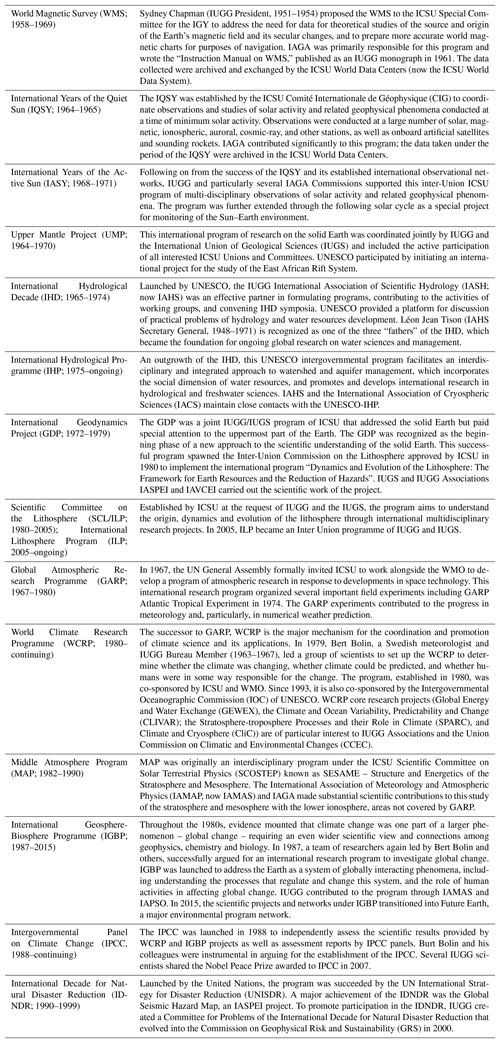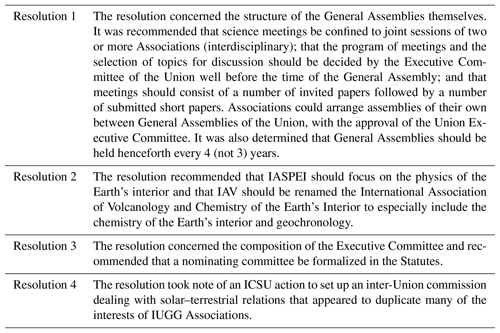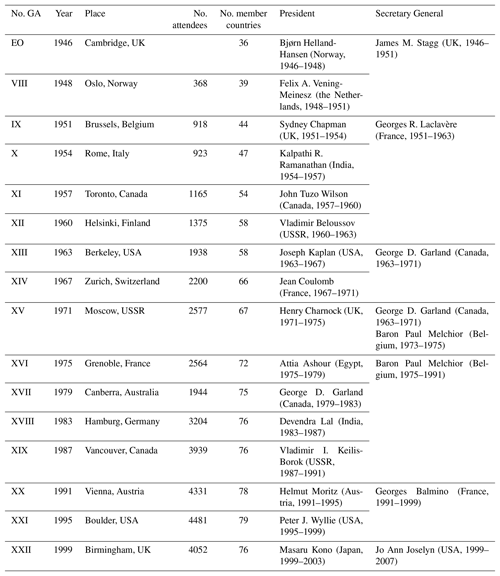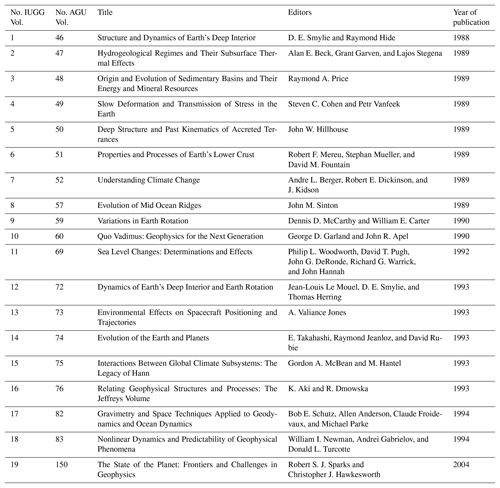the Creative Commons Attribution 4.0 License.
the Creative Commons Attribution 4.0 License.
IUGG evolves (1940–2000)
Jo Ann Joselyn
Alik Ismail-Zadeh
The International Union of Geodesy and Geophysics (IUGG) began anew after World War II with a new governance and membership structure. The technologies developed during the war were brought to bear in the extraordinary global scientific effort that was the International Geophysical Year (1957–1958). Major changes in the geopolitical landscape have brought about further changes in IUGG's structure. International scientific campaigns encompassing multiple disciplines became commonplace, and international scientific bodies were organized and networked. During this time period (1940–1999), 15 general assemblies and 2 extraordinary general assemblies were held, each in a different international venue. Summaries of each general assembly are presented, as well as overviews of the changes in IUGG's structure, finances, membership, and publications. The scientists, who led the Union and contributed to the development of the Union, are also presented.
- Article
(4874 KB) - Companion paper 1
- Companion paper 3
- BibTeX
- EndNote
After 2 decades of international scientific collaboration through the development and growth of the International Union of Geodesy and Geophysics (IUGG), World War II (WWII) brought the Union's activity to a standstill. In this paper, we describe the evolution of the Union for the period from the end of WWII to the end of the 20th century. The most important scientific program in the life of the Union in the 1950s was the International Geophysical Year (IGY, 1957–1958), an initiative of IUGG and some other scientific unions and national members of the International Council of Scientific Unions (ICSU), which was co-sponsored by ICSU and the World Meteorological Organization (WMO). During 1940–1999, 17 IUGG General Assemblies including two extraordinary assemblies were held in Cambridge (UK in 1946, an extraordinary assembly), Oslo (Norway, 1948), Brussels (Belgium, 1951), Rome (Italy, 1954), Toronto (Canada, 1957), Helsinki (Finland, 1960), Berkeley (USA, 1963), Zurich (Switzerland, 1967), Moscow (USSR, 1971), Grenoble (France, 1975), Durham (UK, 1977, an extraordinary assembly), Canberra (Australia, 1979), Hamburg (Germany, 1983), Vancouver (Canada, 1987), Vienna (Austria, 1991), Boulder (USA, 1995), and Birmingham (UK, 1999). Major changes in the geopolitical landscape have brought about further changes in IUGG's structure. International scientific campaigns encompassing multiple disciplines became commonplace, and international scientific bodies were organized and networked. Also, we overview the changes in IUGG's structure, finances, publications, and membership, and highlight the leaders of the Union, who contributed significantly to the promotion of international scientific cooperation during this time period.
Though an invitation from Oslo, Norway was accepted for the proposed General Assembly (GA) in 1942; the Executive Committee had the authority to postpone “should conditions make it necessary” – an authority which they put to use. No general assemblies were held in 1942 or 1945, nor was any IUGG President shown for the years 1943–1945. Following the war, it was necessary to reinitiate the Union. This post-war revival effort was due largely to the efforts of Secretaries General Harold St. J. L. Winterbotham (UK; 1930–1946) and James Stagg (UK; 1946–1951). Even before WWII began, Winterbotham took steps “to safeguard the Union's funds and contrived to keep an emergency organisation running until the end of hostilities” (Stagg, 1947). Stagg also noted that some of the work of maintaining the organization was carried out in a distributed manner through the associations: “Some of the associations, on their side, continued their work in some measure throughout the War, supporting themselves on the annual subscriptions from their own and neighbouring countries” (Stagg, 1947). Both Winterbotham and Stagg were instrumental in post-war reconstruction, assuring the continuation of IUGG and restarting its development.
2.1 Extraordinary General Assembly (29 July–2 August 1946, Cambridge, UK)
An extraordinary GA was called in 1946 to put the Union on its post-war feet. Held in Cambridge, UK, it was attended by delegates from 16 Member countries. IUGG Statutes and By-laws were adopted. A radical change in the method of subscription by Member countries was introduced that allowed the countries to choose one of eight categories of membership. The only proviso was that the category selected had to be formally approved by IUGG's Council, on which every country had one representative. The category of membership determined the annual dues to be paid, and the voting rights in Council discussions involving finance. Delegates to the GA also discussed and endorsed the agreement made between IUGG and the United Nations Educational, Scientific and Cultural Organization (UNESCO). By this agreement, the Union agreed to disseminate information on geodetic and geophysical subjects in countries where contacts on scientific matters were few, and in return, UNESCO agreed to promote international cooperation by financial support for publications and meetings, and geodetic and geophysical services (Stagg, 1947).
2.2 VIII General Assembly (19–28 August 1948, Oslo, Norway)
IUGG President Bjørn Helland-Hansen (Norway) could not attend the GA due to his state of health, and Vice President Niels E. Nørlund (Denmark) acted on behalf of the President. James Stagg was Secretary General. The Opening Ceremony was attended by H.M. the King of Norway and H.H. the Crown Prince. The Government of Norway, the municipality, and the University of Oslo extended generous hospitality to the Union. Two public lectures were presented: “Geophysics, Vocation or Avocation?” by Merle Antony Tuve (USA) and “The Eruption of Mount Hekla, 1947–48” by Sigurdur Thorarinsson (Iceland), who showed a color film on the volcano's eruption (Stagg, 1948). At this GA, the office of Vice President was restored, and the first Finance Committee President was named: John Tuzo Wilson (Canada). Member countries were urged to set up National Committees, if they had not already done so. Each Association held its own scientific assembly during the GA. Cooperation with the International Astronomical Union (IAU) and the International Telecommunication Union (ITU) in topics of geodetic astronomy was highlighted, as was the importance of the International Meteorological Organization (IMO) to serve as a clearinghouse for ideas and to link together the various meteorological research bodies throughout the world. The Joint Inter-Association Committee on the Physics of the Earth's Interior replaced the Union Committee on Continental and Oceanic Structure (Proudman, 1948). The Joint Committee on the Ionosphere proposed a third International Polar Year in 1957–1958. There were seven permanent services such as one on Standard Sea Water Service. IUGG was represented at the 1948 and 1950 meetings of the Pan American Institute of Geography and History (PAIGH).
2.3 IX General Assembly (21–31 August 1951, Brussels, Belgium)
President Felix Andries Vening-Meinesz (the Netherlands) presided. Vice Presidents were Sydney Chapman (UK) and Leason J. Adams (USA), and James M. Stagg (UK) was Secretary General. H.M. Queen Elisabeth of Belgium attended the Opening Ceremony. The Assembly host was the Belgian Committee for Geodesy and Geophysics, chaired by J. F. Cox. It was noted that IUGG had been “born” in Brussels 32 years prior. The attendance of 918 people at the Palais des Beaux-Arts indicates that scientific activities were once again a national priority (Fig. 1). Accounts were managed by the Secretary General and were denominated in English Pounds. The International Polar Year 1957–1958 was approved “in principle”, and the immediate formation of a steering committee was urged in order to allow a full 5 years to make the arrangements. The name of the International Association of Seismology was changed to the International Association of Seismology and Physics of the Earth's Interior (IASPEI). Twenty-four resolutions were adopted by the GA (Cox, 1951).
2.4 X General Assembly (14–25 September 1954, Rome, Italy)
IUGG President Sydney Chapman (UK) presided. The Vice Presidents were Gino Cassinis (Italy) and Jacob Bjerknes (USA). Georges R. Laclavère (France) was Secretary General. The Assembly was hosted by the Consiglio Nazionale delle Ricerche (CNR). The post-WWII period in the development of international cooperation in Earth and space sciences is characterized by change in the scientific and political landscapes. The formation of the United Nations (UN) after WWII broadened the scope of the involvement of IUGG in international scientific cooperation via new scientific programs of the inter-governmental agencies, especially WMO. Its predecessor IMO was founded in 1873 to facilitate the exchange of weather information across national borders. WMO became a specialized agency of the United Nations in 1951 addressing areas of meteorology (weather and climate), operational hydrology, and related geophysical sciences. Relations between WMO and IUGG were formalized by the signing of a working agreement in 1953 whereby IUGG is recognized by WMO as the international forum for the advancement of meteorology while WMO is recognized by IUGG as having the primary responsibility for the international organization of meteorology. WMO and IUGG agreed to keep each other “advised of all developments and projected activities” within the WMO and IUGG fields of interest (WMO, 2002).
Many advances in geophysics, meteorology and ionospheric physics, ultra-high-frequency and microwave radars, jet propulsion, V2 rockets (long-range guided ballistic missiles), new techniques in nuclear physics, solar radio noise, radio astronomy, and radio aeronomy were made during WWII. While there is very little information available about the proceedings of the General Assembly, Joint Commissions reporting at the Assembly included those on Solar and Terrestrial Relationship (with IAU and the International Union of Radio Sciences – URSI); on the Ionosphere (with IAU, URSI, and the International Union of Pure and Applied Physics – IUPAP); on Oceanography (with the International Union on Biological Sciences – IUBS); and on Radio-Meteorology (with URSI). These were busy years for IUGG President Chapman, who was also the President of the Special Committee for the International Geophysical Year (Comité Spécial de l'Année Géophysique Internationale – CSAGI) set up in 1952.
The significance of the International Geophysical Year for IUGG
The International Geophysical Year (IGY) that lasted from 1 July 1957 to 31 December 1958 has a special place in the history of international scientific cooperation of the 20th century (e.g., Launius et al., 2010). “The spectacularly successful International Geophysical Year, run by the International Union of Geodesy and Geophysics, had received acclaim from the scientific world at large” (Harrison, 1978). The IGY was a remarkable project not only because of its outstanding accomplishments and the involvements of thousands of scientists, who contributed to the IGY success, but also because the year gave rise to several major international initiatives (Ismail-Zadeh, 2016).
The IGY was one of the most important global scientific undertakings in the second half of the 20th century, involving policymakers and opening a new era of Earth and space exploration. The Year was conceived during a dinner party in April 1950 at the home of James A. Van Allen, where geophysicists Sydney Chapman, Lloyd Berkner, J. Wallace Joyce, Ernest Vestine, and S. Fred Singer met. The initial aim was to create a third International Polar Year, 25 years after the second IPY (1932–1933), coinciding with the time of solar maximum. In January 1951, IUGG and ICSU endorsed Berkner's proposal to launch a third IPY. Later, at a session of the IX IUGG General Assembly held in Brussels, Belgium, on 23 August 1951 and chaired by IUGG President Sydney Chapman, Johannes Egedal, a Danish meteorologist, argued vigorously that “observations … should be taken all over the earth”, and especially at the Equator as well as at the poles (Bulkeley, 2008). This idea was supported by WMO, whose historical predecessor – the International Meteorological Organization – had launched two previous International Polar Years. Egedal suggested then to Chapman to change the name of the Year from “Polar” to “Geophysical”, and Chapman agreed. The change was endorsed then by ICSU in 1952, and the scope of the International Geophysical Year was broadened to involve all parts of the globe and all branches of the Earth and space sciences (Bulkeley, 2008). The first international planning meeting for the IGY, with 26 nations participating, occurred in 1953. In September 1954, an IUGG resolution, soon backed by CSAGI, called for a satellite program to place instruments in Earth orbit (Sullivan, 1961).

Figure 2Stamps dedicated to the IGY and produced by the USA (the upper left stamp), Norway (the upper right stamp), and the Soviet Union. The texts in Russian of the Soviet stamps read “The pioneer artificial Earth satellite launched by the Soviet Union” (the lower left panel) and “According to the International Geophysical Year program, the Soviet Union launched on 15 May 1958 the third artificial Earth satellite of 1327 kg to a height of 1880 km” (the lower right panel). The images of the stamps are from the Internet (https://www.mysticstamp.com/Products/United-States/1107/USA/\#, https://colnect.com/es/stamps/stamp/48850-International_Geophysical_Year-International_Geophysical_Year-Noruega, https://en.wikipedia.org/wiki/Sputnik_1\#/media/File:Sputnik-stamp-ussr.jpg, and https://zvonmoneta.ru/mark-2586, last access: 30 January 2019).
The IGY's impact can be measured in several ways. First, a staggering number of scientific advancements were achieved during the 18-month period. Ultimately involving some 60 000 scientists from 67 nations, the IGY, through numerous installations and field expeditions, made possible the synoptic collection of observational data on an unprecedented global scale. It emphasized a data-driven style of research, stimulated new graduate training programs, helped establish Earth science programs in many developing and newly independent countries, and made IUGG assemblies a key venue for coordinating and communicating scientific investigations. The IGY made possible a great number of scientific advancements. For example, the 1957 launch of Sputnik by the USSR initiated the Space Age (Fig. 2). The Special Committee on Ocean Research (SCOR – later renamed the Scientific Committee on Ocean Research to reflect its more permanent status) was established in 1957 to address interdisciplinary science questions related to the ocean. Associated with the IGY, a number of interdisciplinary scientific bodies were established in 1958, including the Committee on Space Research (COSPAR) and the Scientific Committee on Antarctic Research (SCAR). The IGY provided a model and inspiration for the Upper Mantle Project, the International Indian Ocean Expedition, and the International Years of the Quiet Sun. The World Data Center system, created to safeguard and share IGY data, reflected a shared desire for scientific internationalism (Aranova et al., 2010; Collis and Dodds, 2008; Korsmo, 2007).
Second, the IGY had a profound effect on geopolitics, and it deeply reflected the politics and political realities of the Cold War from which it emerged (Needell, 2000). Virtually all fields of geophysics became important to military leaders in the aftermath of WWII, as effective utilization of guided missiles and submarines required greatly expanded knowledge involving physical oceanography, terrestrial magnetism, isostasy, seismology, meteorology, ionospheric physics, and solar–terrestrial relationships. IGY architect Lloyd Berkner had written a secret supplement to a high-level report on international science he prepared for the U.S. State Department when the IGY was conceived that stressed the importance of international scientific contacts for intelligence-gathering – and IUGG assemblies in the 1950s and 1960s included covert intelligence agents. IGY research was also valued for providing useful environmental sciences data about the Arctic (deemed a potential East–West battleground, positioned dead center between the USA and the Soviet Union). At the same time, Antarctica was established as a continent for science, resolving long-standing sovereignty claims. Cold War tensions limited national involvement in the IGY (for instance, mainland China ultimately did not take part) and kept certain data from reaching the international data centers. When existing global seismic stations were augmented to create the World-Wide Standard Seismographic Network crucial for verifying the Limited Nuclear Test Ban Treaty of 1963 – a natural extension of IGY-style programs – it was a further reminder that the IGY was simultaneously a triumph of scientific internationalism and an undertaking made possible by national funding decisions reflecting Cold War anxieties (Korsmo, 2007).
Third, the IGY had demonstrated the importance of science diplomacy. By the early 1950s, the Soviet Academy of Sciences did not participate in the activities of almost all international scientific unions coordinated by ICSU, and hence Soviet scientists were not involved in the IGY initial planning. IUGG Secretary General Georges Laclavère expressed that the participation of the Soviet Academy would be essential for the influence of CSAGI to become truly global (Bulkeley, 2008). IUGG President Sydney Chapman recalled that the initial steps taken by IAU and WMO (where the Soviet Union had representatives) to attract the Soviet Union to the IGY led to no result (CSAGI, 1958). In 1952 and 1953, ICSU and IUGG sent several invitations to the Soviet Academy of Sciences to join the IGY. Although several top scientists, including the Academy's President Alexander Nesmeyanov, worked hard to join the IGY program and IUGG, until the death of the leader of the Soviet Union Josef Stalin in March 1953 and consequent political changes, no response to the invitation was received by ICSU. In early 1954, the Soviet Academy decided to take part in the IGY, and also to join IUGG; Nesmeyanov sent Chapman the first indication that this was about to happen. The Soviet Academy's decision in favor of the IGY and IUGG was a part of a larger process of the post-Stalin perestroika and science diplomacy efforts (Bedritskii et al., 1997; Bulkeley, 2008).
2.5 XI General Assembly (3–15 September 1957, Toronto, Canada)
IUGG President Kalpathi Ramanathan (India) presided. Other members of the Bureau were J. Tuzo Wilson (Canada), the solitary Vice President, and Secretary General Georges R. Laclavère (France). The General Assembly, the second in North America, was hosted by the National Research Council (NRC) of Canada (the Canadian National Committee for Geodesy and Geophysics) and the University of Toronto. The Prime Minister of Canada, John G. Diefenbaker, and the President of the NRC, Edgar W. R. Steacie, greeted the delegates from more than 50 countries. Public lectures were given by ICSU President Lloyd V. Berkner on “Scientific Aspects of the Instrumented Earth Satellite” and by Yevgeny I. Tolstikov on “The Arctic and Antarctic Program of the IGY”.
At this GA, the Statutes and By-laws of the Union first adopted in 1946 were revised; for the first time, IUGG Bureau members were elected. The Bulletin, begun by Laclavère in 1952, was split into two publications in 1956. The Chronicle, containing information about programs and proceedings, began in May 1957; and scientific articles were published separately. An International Journal of Geodesy and Geophysics was proposed (but never happened), as was an International Bibliography of Geophysics and a Directory of Geodesists and Geophysicists. Already there was concern to engage larger numbers of young scientists in IUGG activities. The International Association for Terrestrial Magnetism and Electricity (IATME) became the International Association for Geomagnetism and Aeronomy (IAGA; note that an initial suggestion was the International Association for Geomagnetism and Physics of the Ionosphere). A committee was formed by the International Association of Geodesy (IAG), IAGA, and IASPEI to organize the World Magnetic Survey. There were inter-Association (joint) commissions on the Upper Atmosphere (International Association of Meteorology – IAM and IAGA) and Atmospheric Electricity (also IAM and IAGA).
Planning for the IGY was a priority during the period. Particularly, IUGG (along with URSI and IAU) had an important role in establishing the Federation of Astronomical and Geophysical Permanent Services (FAGS) in 1956, funded substantially by UNESCO. Some of the nine permanent services and their related Associations were the International Gravimetric Bureau (of IAG), the Bureau for Geomagnetic Indices (of IAGA), and Mean Sea Level (of the International Association of Physical Oceanography –IAPO). IUGG became a member of SCOR as well as the Joint Commissions on Solar-Terrestrial Relationships; the Ionosphere; Radio-Meteorology; and Applied Radioactivity. ICSU initiated a Special Committee on the Biological Effects of Nuclear Radiation. IUGG began attending meetings of the Cartographic Office of the UN in 1955. A permanent liaison was established with PAIGH in 1954 and WMO in 1957.
Twenty-three Union resolutions were published in French, English, and Russian (IUGG Archives, 1957). They dealt with issues concerning combined membership of the German national committees, the Chinese national committees, and Cuba; adoption of a standardized value for the speed of light; the need and methodology for geodetic and gravity measurements; the need to deep drill into ocean sediments and further into the Mohorovicic discontinuity; that ICSU restore a budget cut to the International Seismological Summary; that improved observations and analysis of atmospheric ozone be supported; that countries use alternating current electric power because direct current for railways hinders geomagnetic measurements; that the World Magnetic Survey be supported and the data published; that a permanent Service on the Variations of Mean Sea Level be created; that quantitative data on chemical substances dissolved in water from land surfaces be collected; and that volcanoes be reported, rocks collected, and volcanic gasses analyzed.
2.6 XII General Assembly (26 July–6 August 1960, Helsinki, Finland)
IUGG President J. Tuzo Wilson (Canada) presided. Vice Presidents were Vladimir V. Beloussov (USSR) and Wikko Heiskanen (Finland), Secretary General Georges R. Laclavère (France) and members George Deacon (UK), J. Wallace Joyce (USA), and Tsuji Chuboi (Japan). The Government of Finland and University of Helsinki hosted the Assembly. The President of the Republic and the Minister of Education attended the Opening Ceremony. The GA was attended by scientists from 58 member countries and observers from 10 non-member countries.
Finances were a major concern of the IUGG Council. President Wilson noted that there were fair income and adequate reserves in 1948. But, in the meantime, the number of members had increased and so had costs for added programs and publications (half of the Union's work was publications). Dues were increased, and the IUGG Statutes and By-laws were revised to include the office of Treasurer. A nominating committee was defined. Countries not paying dues would not receive free publications, and the Council could decide to terminate membership. Voting rules were prescribed: all delegates had one vote on the topics of scientific matters, paid-up members could vote on administrative matters, and the number of units of membership was counted for financial matters. There would be a General Assembly every 3 years. The new Statutes and By-laws were printed in French, English, and Russian.
The inter-Association bodies were Geophysical Bibliography; Upper Mantle Project; Tsunami; and the Committee on Space Research (CSR). The IUGG CSR was a response to COSPAR, the ICSU Committee on Space Research, which seemed to be encroaching on IUGG interests and expertise. The Committee on Geophysical Bibliography decided to employ existing Bibliographic services, and dissolved. IUGG endorsed the ICSU Policy on non-discrimination. Three International Scientific Unions (IUGG, IAU, and IUPAP) supported ICSU's Special Committee for Geophysics (Comité Internationale de Géophysique – CIG). The CIG approved three projects: the World Magnetic Survey, the Upper Mantle Project, and the International Years of the Quiet Sun. ICSU also approved the constitutions of the Inter-Union Committees on Radio Meteorology (IUCRM), on the Ionosphere (IUCI), and on Solar Terrestrial Relationships (IUCSTR). FAGS acquired two new services: the International Time Bureau (Bureau International de l'Heure) and General Bathymetric Chart of the Oceans.
Twenty-one Union resolutions were passed (IUGG Archives, 1960). They concerned the IUGG Publication office; that metric units were recommended for use in all scientific papers; that the Committees on Space Research, Near Shore Oceanography, Meteorology of the Upper Atmosphere, and Dynamical Meteorology should be formed; that there should be increased support for the International Latitude Service and that a permanent service should be established on the General Bathymetric Chart of the Oceans; that meteorological data should be made available for research; that the Tsunami Committee should establish a warning system; that lunar influences on geophysical processes should be investigated; that a document, “Codification of rules for protection from Volcanic eruptions”, should be printed and distributed, as well as a quarterly “Bulletin of Volcanic Eruptions”; that seismological research be done in central and South America and eastern Europe, and that a catalog of earthquakes from 1801 to 1900 be prepared; that programs of gravity measurements should be accelerated; and that satellites with flashing lights and devices for electronic tracking be launched.
The period of time between the 12th General Assembly (1960) and the 22nd General Assembly (1999) was marked by profound shifts, both scientifically and politically. The legacies of the IGY and the realization that the best scientific outcomes come from both international and interdisciplinary cooperation extend to today. The discoveries in Earth and space sciences (e.g., the extent and morphology of Earth's magnetic field) and the observations of Earth as a planet have irrevocably shaped every discipline within the IUGG purview. Simultaneously, geopolitical forces reshaped the geographic landscape. A comparison of the 58 national Members adhering to IUGG in 1963, with the 76-Member roster in 1999, shows the growth in the number of Member countries of the Union (Appendix A). 49 Members remained, some had relinquished membership, three had ceased to exist as a single entity (Czechoslovakia, USSR, and Yugoslavia), and “new” countries had appeared. Thirteen of those had not existed in 1960, and the others were countries that had built the capacity to take their rightful place in geophysical society. Twelve other countries were briefly members during those 36 years. These countries acquired membership after 1963, but were removed from the membership list before 1999; examples are the Democratic Republic of Germany, and the Republic of China, whose memberships were cancelled because of the reunification of Germany in 1990, and the admission of the People's Republic of China in 1977, respectively. These were a noteworthy 39 years of global as well as IUGG history.
3.1 Inter-Union Scientific Campaigns and Programs
Throughout this time of evolution, IUGG was strongly guided by ICSU as well as by developing relationships with other governmental and non-governmental national and international bodies. While these relationships are introduced chronologically in Table 1, the major inter-Union programs of interest to IUGG are summarized first. These programs illuminate the overarching geophysical scientific focus through these years.
Throughout the years, the Associations and inter-Association bodies have sponsored numerous topical scientific symposia, many intentionally convened in developing countries. The records of the Union list these symposia that educated and promoted progress in the various disciplines of study. IUGG often provided support for these meetings, especially to ensure the attendance of young scientists and those from financially disadvantaged countries.
3.2 IUGG Structure
There were several proposals to radically change IUGG between 1960 and 1999. At the 1963 GA held in Berkeley, California, USA, President Joseph Kaplan initiated extended discussion of the future of IUGG, then 44 years old. The growing attendance at the General Assemblies was one of the main issues, and it was also an important consideration in the scheduling of the next Assembly, because no bid had been received. A special meeting of the Council was held to consider possible reorganization. As a result, two committees were named; a “Committee of 4” composed of four people appointed by the incoming President; and a “Committee of 14” composed of 14 people (7 people were appointed by Associations, each of them had one representative in the committee, and 7 people were appointed by the IUGG Council) and this committee did not include members of the Bureau. Each IUGG National Committee and each IUGG Association was requested to submit recommendations for consideration to the first committee. In the fall of 1964, the “Committee of 4” issued a report with an appendix that included copies of all material submitted by National Committees and Associations. In January 1966, the “Committee of 14” met in Paris and affirmed that any reorganization should preserve the autonomy and freedom of action that the Associations had always enjoyed. The “Committee of 14” then issued four Resolutions (Table 2).
The second major attempt at IUGG reorganization came on the heels of Resolution 4. COSPAR, established by ICSU in 1958, enabled ongoing international and interdisciplinary cooperation among the scientific investigations carried out with space vehicles, rockets and balloons. However, several of the ICSU Unions (IUGG, IAU, the International Union of Pure and Applied Physics (IUPAP), and URSI) laid claim to these new observations and developing science. To address the rising conflicts, ICSU formed the Inter-Union Commission on Solar-Terrestrial Physics (IUCSTP) in 1966, replacing a former Joint Committee on Solar-Terrestrial Relationships formed in 1958. However, URSI, IAGA, and IUCSTP were each addressing the same external geophysics (primarily the division between internal and external geomagnetism), and a committee was established to consider reorganization of parts of ICSU to address these conflicts. Marcelle Nicolet, President of IAGA, represented IUGG in the negotiations and in March 1970 a proposal was offered that would combine the present responsibilities of IUCSTP, URSI, IUGG into nine “associations” that would cover, without duplication, the separate responsibilities of (i) Radiophysics, (ii) Geomagnetism, (iii) Aeronomy, (iv) Geodesy, (v) Seismology, (vi) Volcanology, (vii) Meteorology, (viii) Oceanography, and (ix) Hydrology. It was proposed that these units could be then federated into one, two, or three separate Unions within ICSU. However, at the 1971 IUGG General Assembly in Moscow, the IUGG Council received word that URSI had rejected all of the proposals including the ideas of federation. In 1972, ICSU changed IUCSTP to a Special Committee for the purpose of coordinating short-term programs requiring the cooperation of several ICSU bodies and the direct participation of national groups. In 1978, IUCSTR became an ICSU Scientific Committee on Solar Terrestrial Physics (SCOSTEP), to which IUGG maintains a liaison to the present day.
At the 1975 GA in Grenoble, France, a subcommittee under the control of the Bureau was formed to consider IUGG's structure. A “radical” reorganization of IUGG was proposed in the late 1980s, in which IUGG would be divided into two “Super-associations”, one for the fluid Earth (International Association of Hydrological Sciences (IAHS), the International Association of Meteorology and Atmospheric Physics (IAMAP), the International Association of the Physical Sciences of Oceans (IAPSO), and parts of IAGA) and the other for the solid Earth (IAG, IASPEI, the International Association of Volcanology and Chemistry of the Earth's Interior (IAVCEI), and other parts of IAGA). These two “Super-associations” would operate independently of each other, with general guidance from the Union. The idea was rejected by IAGA because splitting IAGA into fluid Earth and solid Earth parts would not accommodate the study of planets. Furthermore, the interests of the National Members might not be served under this arrangement and the notion was discarded.
In 1989, President Vladimir Kellis-Borok convened an Advisory Board on Scientific Policy to look at the goals of the Union and make recommendations concerning its missions and objectives. In 1991, the Board was expanded to include the Presidents of the Associations and was chaired by IUGG Vice President Peter J. Wyllie. The Board gave a report at the 1995 GA in Boulder, Colorado, USA, and proposed revisions to the Statutes.
The composition of the Union officers has changed over the years. In 1960, there were two Vice Presidents and two Bureau members in addition to the President, Secretary General, and the Treasurer (begun after the 1957 GA in Toronto, Canada). The Executive Committee consisted of the Bureau, the immediate Past President, and the Presidents of the Associations (Associations Secretaries General could attend in an advisory capacity). At the 1971 GA in Moscow, the IUGG Statutes were modified such that the Bureau consisted of the President, one Vice President, Secretary General, Treasurer, and three members. At the same GA, there was a suggestion from the United States that IUGG should establish a permanent Secretariat but the proposition failed. At the 1995 GA in Boulder, the role of the Past-President was changed from a voting to a non-voting member, so that the Bureau could not out-vote the Associations in Executive Committee meetings. The procedures for nominations for Union officers were clarified at the 1999 GA in Birmingham, especially with regard to nominations at the time of the General Assembly.
Over time, there has been natural tension between the Associations and the Union, with respect to the autonomy of the Associations and the benefits of being a common Union. Such tension has risen at certain times and has been resolved at others. At the 1971 GA in Moscow, it was noted that several Associations had held their own assemblies and elected officers. This had not been visualized as a possibility, but it seemed not to cause difficulties. At the 1979 GA in Canberra, the IUGG By-law stating that Associations could not hold their own scientific sessions during IUGG General Assemblies was removed. Beginning after the 1983 GA in Hamburg, a review of the Associations was initiated. A “Fluid Earth Sciences Committee” was established in 1991, comprised of the Presidents of IAMAP, IAHS, and IAPSO and chaired by the IUGG President; it was disbanded in 1995. IAPSO did not attend the 1995 GA in Boulder, Colorado, USA, choosing instead to meet separately in Hawaii. At the 1995 GA in Boulder, it was agreed that there would be no Association sessions during Union Lectures. Following this GA, the concerns and tensions between the Associations and the Union, including any possibility of splitting the Union into “solid” and “fluid” parts, were reconciled.
3.3 IUGG finance
Since 1946, the Union has been funded primarily by payments by its National Members according to category of membership (which carry prescribed numbers of units). Associations are funded by subventions from the Union as well as by grants and direct support for specific programs from ICSU, UNESCO, and other bodies. Needless to say, the finances of IUGG, especially in terms of the price of a unit of membership and the distribution of funds to the Associations, have been under constant discussion.
IUGG finances were kept in British pounds until 1960; after that the accounts were denominated in US dollars. In 1963, the IUGG Council decided that a Member Country could raise its category of membership unilaterally, but that a vote of the Council was required to reduce it. At the 1971 GA in Moscow, the unit of membership was increased to USD 600, and there was considerable discussion about how IUGG funds were allocated to the Associations. At the 1975 GA in Grenoble, the unit of subscription was raised to USD 800 effective in January 1977. Regarding financial allocations to the Associations, it was decided that IAG and IAGA would be considered large associations and should receive equal annual allocations of approximately USD 19 000; IASPEI, IAMAP, and IAPSO medium-sized associations that should receive equal annual allocations of approximately USD 14 000; and IASH and IAVCEI two small associations that should receive equal annual allocations of approximately USD 10 000. At the 1983 GA in Hamburg, due to a worsening financial outlook, the allocations to the Associations were reduced by 20 %, and it was decided, amid strong objections from some national members, to raise the IUGG dues to USD 850 in 1985 and then to USD 900 in 1986. In 1983, the GA in Hamburg approved two higher categories of membership (11 and 12, with 35 and 40 units, respectively). By the 1987 GA in Vancouver, the finances of the Union were deemed acceptable and the value of a unit, USD 900, was maintained as were the allocations to the Associations. The GA registration fee came under discussion as being too high (the Vancouver GA ended with a small surplus). At the 1991 GA in Vienna, the IUGG Council decided to raise the unit of membership annually in 10 % steps up to USD 1200 in 1995, and the Finance Committee moved that USD 20 be added to the registration fee for the next GA and then distributed to the Associations on the basis of participation. At the 1995 GA in Boulder, the Council decided to automatically increase the unit of subscription annually based on the OECD consumer price index.
Registration fees and financing of the General Assemblies became an issue at the 1995 GA in Boulder. At this assembly, fees for attending just 1 week of what was normally a 2-week Assembly were introduced, but there was no Geohost program – a pool of money from which the registration fees of scientists from developing countries could be paid. It had been thought that support could be found for scientists from the former Soviet Union but that failed to happen. The American Geophysical Union (AGU) reported a deficit for the Boulder Assembly and the invitation for the 1999 Assembly in the UK came with a condition: the UK did not want to accept financial responsibility. Ultimately, the issue was resolved through special arrangements, including the formation of an Oversight Committee. The 1995 GA resolved that detailed invitations must reach the Secretary General not later than 3 months before the GA preceding the GA of the invitation, and should include efforts to subsidize travel, registration fees, and other expenses of scientists from developing countries and of young scientists from all countries. At the 1999 GA in Birmingham, the IUGG Council resolved that the host countries for general assemblies should henceforth carry the financial burden. A memorandum, “On invitations for IUGG General Assemblies”, was developed.
3.4 IUGG publications
Early in its history, IUGG spent much of its money on publications, which it deemed to be a major responsibility. Georges Laclavère (Secretary General, 1951–1963) directed for many years the Publications Office of the Union hosted by the Institut Géographique National. The Office published the Chronicle beginning in 1957 as well as monographs (21 were published between 1960 and 1963; the first one was “Seismicity of Europe” produced in June 1960). The Chronicle was free to members (four copies/unit of membership) for personal use; otherwise, there were paid subscriptions, especially by libraries. The costs of publishing the Chronicles as well as other scientific papers became such that at the 1971 GA in Grenoble, it was decided to discontinue the publishing of monographs. In addition, a committee chaired by Georges Laclavère was appointed to consider the future of the IUGG Publication Office because his retirement from his former government post would limit the facilities available to him. By 1981, the IUGG directory (the Yearbook) was published every 4 years as one or two issues of the Chronicle. The Yearbook for 1989 was published as Chronicle issues 195–196, but also on a diskette. The Publications Office closed in 1990. Former IUGG Secretary General Paul Melchior (1973–1991) continued the Chronicles from his office in Belgium until publication ceased in 1995.
3.5 IUGG membership
At the conclusion of the 1999 GA in Birmingham, the Union had three categories of membership: Regular (with the right to vote), Observer, and Associate, but this had not always been the case. Until 1991, a National Member either paid its dues or it was not a member. In 1991, an Observer category was defined for Member countries whose payments were temporarily in arrears. Associate membership was added at the 1999 General Assembly. As a result of these options, the membership in the Union changed annually as countries either met the qualifications of membership, changed category, or departed from membership. One special case was that of the Federal Republic of Germany (FRG) and the German Democratic Republic (GDR). The FDR joined in 1951; the GDR applied for membership in 1952 and at the IUGG General Assemblies in 1957, 1960, and 1963 they shared a vote. In 1967, the GDR acquired independent membership. At the end of 1990, the GDR and FRG reunited, so the number of Member countries decreased by one. Another special case was that of the memberships of the Republic of China (ROC) and the People's Republic of China (PRC). This case resulted in an Extraordinary General Assembly in 1977, described in more detail below. At that time, the PRC replaced the ROC; in 1995 the IUGG Statutes and By-laws were revised to permit two Adhering Bodies for China.
Before 1979, all of the attendees of the General Assembly had been asked to approve the decisions of the Council. But that was removed and replaced by a requirement for a plenary session that has been subsumed into the Opening and Closing Plenaries. Also in 1979, a provision was added that the Council could be convened between General Assemblies if requested by a simple majority of the Executive Committee. In 1983, voting rules, especially with regard to a quorum and the numbers needed for a positive outcome, were added to the By-laws.
4.1 XIII General Assembly (19–31 August 1963, Berkeley, California, USA)
IUGG President Vladimir V. Beloussov (USSR) presided. Vice Presidents were Julius Bartels (F. R. Germany) and Joseph Kaplan (USA); Georges R. Laclavère (France) was Secretary General and Maharajapuram S. Krishnan (India) and Takesi Nagata (Japan) were Bureau Members. The US National Academy of Sciences issued the invitation. The Assembly was co-hosted by the US National Committee for IUGG (Tom Malone, Chair) and the University of California. The American Geophysical Union handled the general arrangements, and David K. Todd of University of California led the Local Organizing Committee. Harrison Brown, Foreign Secretary of the National Academy of Sciences, spoke and a welcoming message from US President John F. Kennedy was read. Jerome Wiesner, Director of the Executive Office of Science and Technology, addressed the Opening Ceremony. Participation in the General Assembly was enhanced by an International Symposium on the IGY, held at the University of California at Los Angeles preceding the assembly.
The Council received the first Treasurer's report. Reports were received from the Tsunami Commission as well as from FAGS and the liaisons to SCAR, SCOR, and COSPAR. A special committee was appointed to clarify rules for admission of new countries, especially applications from the ROC and the GDR. Other IUGG scientific committees included those on Geophysics Bibliography, Space Research, the Upper Mantle Project, the International Hydrographic Decade, Problems of Geochemistry, and an Inter-Association Heat Flow Committee. IAG changed its organizational structure as a result of the availability of artificial satellites for geodetic applications.
Representatives were named to the Inter-Union Commission on the Ionosphere (IUCI), replacing the Mixed Commission on the Ionosphere (dissolved in 1958); the Joint Committee on Solar Terrestrial Relationships; and the Inter Union Commissions on Radio-Meteorology (IUCRM), Applied Radioactivity, and an Ad hoc Committee on Problems of Geochemistry. Liaisons were appointed to UNESCO, the UN Cartographic Office, WMO, PAIGH, and the Pacific Science Association (PSA). A liaison to the Pan Indian Ocean Science Association (PIOSA) was discontinued following this Assembly.
Forty Union resolutions were passed (IUGG Archives, 1963). They included support for the World Magnetic Survey, the International Years of the Quiet Sun, the Upper Mantle Project, and expedited transmission of geophysical data to the World Data Centers; requests that ICSU approach ITU to arrange for an allocation of frequencies for electro-magnetic distance measurements; that an existing regional warning system for tsunamis be regarded as the nucleus of an International Tsunami Warning System; that improved heat flow measurements be taken; that more aeromagnetic surveys be done and improved ground-based magnetic measurements be made; that a joint Panel of Experts on Oceanographic Tables and Standards be supported; that UNESCO should call upon IUGG to serve as the scientific advisor of the International Hydrological Decade; and that a Permanent Service on the Fluctuation of Glaciers be formed.
4.2 XIV General Assembly (25 September–7 October 1967, Zurich, Switzerland)
IUGG President Joseph Kaplan (USA) presided. Other members of the Bureau were Vice Presidents Keith E. Bullen (Australia) and Jean Coulomb (France), Secretary General George Garland (Canada), Treasurer Einar Andersen (Denmark), and members Bert Bolin (Sweden) and Valery Troitskaya (USSR). The invitation from the Swiss Academy of Sciences (Schweizerische Akademie der Naturwissenschaften) to host the General Assembly was not received until 1965. To accommodate the Assembly, meetings of Council and Plenary Sessions were held in Zurich and Association programs were distributed across Zurich (the International Association of Volcanology (IAV), IASPEI), Bern (IASH, IAPO), St. Gall (IAGA), and Lucerne (IAG, IAMAP). Fritz Kobold was Chair of the Swiss Local Organizing Committee; the green–blue–white logo representing the Earth, the ocean, and the atmosphere that IUGG uses today originated with the Swiss local organizing committee for this Assembly (Fig. 3). Once again, no venue for the 1971 General Assembly was apparent, and the matter was left to the incoming officers.
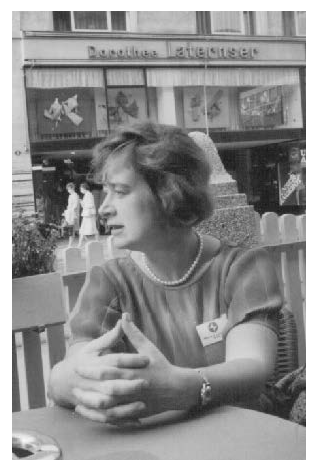
Figure 3Elena Lyubomova (USSR delegate) at the General Assembly in Zurich. Note the badge with the IUGG logo used for the first time (photo: courtesy of Seiya Uyeda).
During the quadrennium, ICSU created the Committee on Water Research (COWAR) to promote contacts between the Unions dealing with water issues. IUGG became instrumental in the Upper Mantle Project. The Union Committee on Problems of Geochemistry was (temporarily) disbanded and absorbed into the newly renamed International Association on Volcanology and Chemistry of the Earth's Interior (IAV became IAVCEI). IAPO also changed their name to IAPSO (“Physical Sciences of the Ocean” instead of “Physical Oceanography”).
Twenty-five Union resolutions were passed (IUGG Archives, 1967). They urged establishment and continuation of geophysical observatories for water resources, heat flow, seismology, volcanology (especially in Iceland and Italy), and geomagnetism; support of the Upper Mantle Project, the International Active Sun Years, the International Geological Correlation Programme (IGCP), an inter-agency Working Group on Statistical Data on Wind and Waves (already concerned with maritime pollution), the Geodetic Reference System 1967, and development of a world volcanology map. The assembly approved the charter for the Central Bureau for Satellite Geodesy and IUGG's participation in the Global Atmospheric Research Programme.
4.3 XV General Assembly (2–14 August 1971, Moscow, USSR)
IUGG President Jean Coulomb (France) presided. Other members of the Bureau were Vice Presidents Hisashi Kuno (Japan, 1967–1969) and Liviu Constantinescu (Romania, 1969–1971), Secretary General George Garland, Treasurer Einar Andersen (Denmark), and members Liviu Constantinescu (Romania, 1967–1969), Thomas Malone (USA), and Alexei Oboukhov (USSR). The President of the Soviet Organizing Committee was Alexandar P. Vinogradov; the Opening Ceremony was held in Kremlin Congress Hall (Fig. 4) and scientific meetings were at the Moscow State University. It was noted that delegates from the People's Republic of China were unable to get visas to attend the assembly because of the Sino-Soviet ideological split between the Communist parties of PRC and of USSR and ongoing border military conflict.
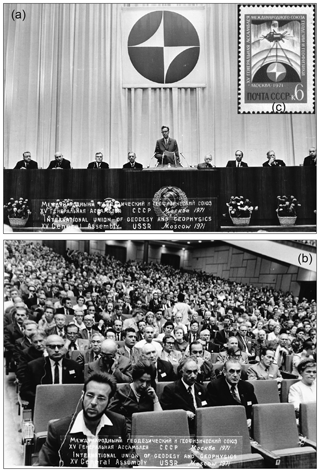
Figure 4XV General Assembly in Moscow, USSR. (a) Opening ceremony and (b) delegates attending the ceremony in the Kremlin Congress Palace Hall (photos a and b: courtesy of Alik Ismail-Zadeh). (c) The USSR produced a stamp on the occasion of the IUGG General Assembly (photo: https://commons.wikimedia.org/wiki/File:The_Soviet_Union_1971_CPA_4005_stamp_(Satellite_over_Globe).jpg, last access: 30 January 2019).
In response to growing concerns about the detrimental effects of human populations, ICSU established the Scientific Committee on Problems of the Environment (SCOPE) in 1969. IUGG/IUGS began to develop an Inter-Union Commission on Geodynamics. Reports were received from the Tsunami Commission and the Upper Mantle Committee. The Union established a Working Group on Advice to Developing Countries, to coordinate with the ICSU Committee on Science and Technology in Developing Countries (COSTED). A new Union Committee on Geochemistry found support. Because considerable progress had been made in the understanding of hydrological processes, IASH became IAHS (“Hydrological Sciences” instead of “Scientific Hydrology”); its Statutes and By-laws were revised and its scientific structure was reorganized. The inter-Association Committee on Mathematical Geophysics (CMG) was established at this General Assembly. It originated with the former Upper Mantle Committee's Working Group on Geophysical Theory and Computers. The CMG, under the leadership of Vladimir I. Keilis-Borok, continued to organize symposia such as the eight annual symposia on geophysical theory and computer applications that had been held from 1964 through 1971.
Twenty-one Union resolutions were passed (IUGG Archives, 1971). They supported adoption of the International Gravity Standardization Net 1971 (correcting a 1909 datum), and continuations of the work begun by the International Magnetospheric Study and the Global Atmospheric Research Programme, and approval of an international and inter-Union study group under the auspices of IAG to strengthen cooperation on lunar laser ranging experiments and theory. Several resolutions emphasized the need for new geophysical measurements such as for ozone (both with ground-based and satellite instruments), boundary-layer phenomena (oceanic and atmospheric), high-altitude (about 50 km) wind and air temperatures, lunar and tidal effects on the magnetosphere, the solar constant, the optical properties of aerosols and clouds, active and dormant volcanoes to study the potential benefits of geothermal energy, tide gauge measurements (mean sea level), and the absolute density and conductivity of seawater. Resolution 20 sought an understanding of Planet Earth and supported a United Nations Conference on the Human Environment (June 1972) and declaration of a special Environmental Period to “start the process of bringing together the environment and man into a harmonious state.”
4.4 XVI General Assembly (25 August–6 September 1975, Grenoble, France)
IUGG President Henry Charnock (UK) presided. Other members of the Bureau were Vice President Attia Ashour (Egypt); Secretary General George Garland (Canada, until 1973) and Adjoint Secretary General Paul Melchior (Belgium, 1971–1975), Treasurer Elvin Kejlso (Denmark), and members William Ackermann (USA), Liviu Constantinescu (Romania), and Nikolai Shebalin (USSR). The Assembly was held on the campus of the University at Saint Martin D'Hères and hosted by the French National Committee for Geodesy and Geophysics (of the French Academy of Sciences), chaired by Georges Laclavère. Participants included guests from UNESCO, WMO, and the International Atomic Energy Agency (IAEA). There were Union Lectures, and more than thousand papers were presented. There were reports from the Inter-Union Commission on Geodynamics; the inter-Association Committee for Advice to Developing Countries, CMG, the Tsunami Committee and the Commission on Geochemistry. A Joint IASPEI-IAGA Inter-Association Commission on Planetary Sciences was initiated.
Twenty Union resolutions were passed (IUGG Archives, 1975). They included the adoption of ICSU Resolution 8 concerning the right to free movement of scientists, and expressions of support for the World Data Centers and the Middle Atmosphere Program. The Union noted concern that human activities might be producing changes in stratospheric composition and recommended that nations monitor and evaluate long-term trends. Several resolutions addressed adoption of uniform values (the speed of electromagnetic radiation in vacuo) and terminology, including use of SI units in geodesy and geophysics and standard legends in hydrological maps. Recommendations included changes in the constitution of the IUCRM and inclusion of radio oceanography, and a volcanology research center in the Pacific. The Union supported the work of the IAHS International Commission for Snow and Ice to produce a World Inventory of Perennial Snow and Ice Masses, the need for a better determination of the solar constant, improved polar motion measurements using Doppler satellite tracking, and low-altitude satellite magnetic survey data.
4.5 Meeting of the Council and Extraordinary General Assembly (6 August 1977; Durham, UK)
IUGG President Attia Ashour (Egypt) presided. Other members of the Bureau were Vice President George Garland (Canada), Secretary General Paul Melchior (Belgium), Treasurer Elvin Kejlso (Denmark), and members Nicolai Shebalin (USSR), Henri Lacombe (France), and Carl Kisslinger (USA). Forty-six Member countries were represented, and nine countries voted by correspondence on a three-part motion to admit the People's Republic of China (PRC) into membership. The motion passed by a vote of 47 to 7 with 1 abstained. The motion also indicated that “the representation assumed until now by the Taiwan delegation must be cancelled”. This was because the IUGG Statutes did not permit more than one Adhering Body per member country.
To briefly describe the circumstances that led up to the Extraordinary General Assembly (EGA), the Republic of China (ROC) became a constitutional entity in 1912, but national and international conflicts resulted in a division in 1949 such that most of the land mass became part of the PRC, based in Beijing. There had been discussions as early at 1956 that the PRC should be invited to apply for membership in IUGG (they were a participating country in the IGY). However, it was the ROC that first submitted an application in 1957 and after much discussion, the ROC was admitted at the IUGG General Assembly in Zurich (1967). In 1971, the United Nations expelled the ROC as a member, accepting instead the PRC. Several other nations followed suit and cancelled diplomatic recognition of the ROC. In 1974, the PRC formally refused to participate in ICSU programs because the ROC had not been expelled from ICSU membership.
Because Australia did not recognize the ROC, no visas could be issued to any Taiwanese visiting scientists at the IUGG General Assembly in Canberra (1979) “other than in a private capacity”. In addition, in 1976 the International Union of Geological Sciences had voted to cancel the IUGS membership of the Republic of China, and approved an application for membership by the People's Republic of China. So it is no surprise that IUGG took the measures they did – but the story does not end there.
ICSU had long upheld non-discriminatory policies with regard to the rights of scientists. An ICSU resolution passed in 1958 affirmed the right to participate in scientific activities “without regard to race, religion or political philosophy.” A resolution on the Free Circulation of Scientists passed in 1963 asked that its member Unions, with regard to all scientific meetings, “ensure the fundamental right of participation, without any political discrimination”. This policy was reaffirmed in 1966 and 1972 and was incorporated in the ICSU Statutes in 1972. At the ICSU Assembly in Washington D.C., USA (1976), a resolution on the Principle of Universality was passed which expressed “eagerness” to welcome the scientific community of the People's Republic of China while recommending that Unions provide for adherence by scientific communities through an appropriate scientific institution “provided they can be listed under a name that will avoid misunderstanding about the territory represented.”
In 1982, the 19th General Assembly of ICSU (Cambridge, UK) admitted the China Association for Science and Technology (CAST) while affirming that the “Academy located in Taipei, China, shall retain its present membership in ICSU”, and urged amendment to Union Statutes that would “promote the universality of science.” In 1995, the IUGG Council changed Statutes 4 and 5 so that “under extraordinary circumstances, the Council of IUGG … may admit a suitably designated additional Adhering Body for a country.” Consequently, “the Academy of Sciences located in Taipei, China” was admitted as a member in Category IV, and remains a member today.
4.6 XVII General Assembly (3–15 December 1979, Canberra, Australia)
IUGG President Attia Ashour (Egypt) presided, and the members of the Bureau were the same as for the 1977 Extraordinary General Assembly. The Australian Academy of Sciences hosted the Assembly; Peter V. Angus-Leppan was Chair of the Organizing Committee and Bruce P. Lambert was Executive Director. This was the first General Assembly of the Union in the Southern Hemisphere, and was held on the campus of the Australian National University. Sir Zelman Cowen, Governor-General of Australia, addressed the Opening Ceremony. The program featured Union Lectures, inter-Association symposia, and scientific committee meetings.
IUGG Committees on Advice to Developing Countries, Mathematical Geophysics, and Geochemistry were active during the quadrennium, plus one on a “Standard Earth Model.” A report from a task group that began in 1977 examining whether to present a joint IUGS/IUGG program to ICSU to study the lithosphere was approved. Termination of the Inter-Union Commission on Geodynamics was extended to 1980. The purview of the IUCRM (Radio-Meteorology) was expanded to include Radio-Oceanography. Apropos to the business of the EGA in 1977, the delegates were asked if they were in favor of an ICSU proposal to replace the word “country” with “territory” in the Statutes, which would then permit both the ROC and the PRC to be members. The vote failed.
Seventeen Union resolutions were passed (IUGG Chronicles, 1980). The resolutions supported the (now Abdus Salam) International Center for Theoretical Physics in Trieste, Italy; the Alpine Experiment within GARP/WCRP; the International Polar Motion Service; financial aid by FAGS to the Service for Mean Sea Level; and an IAU resolution that the IAU Working Group on the Determination of the Rotation of the Earth be reconstituted to be joined with IUGG. The Union recommended that Geodetic Reference System 1980 replace an earlier version; that the IAU reconsider its choice of a nutation series to determine Earth orientation parameters; that ICSU encourage UNESCO to establish a Natural Hazards Unit; and again urged that a center for volcanology research be established in the Pacific. The Union endorsed continued development and application of space methods for geodetic observations and requested that COSPAR formally include the IAG Commission on International Coordination of Space Techniques for Geodesy and Geodynamics within its structure. The Union acknowledged the contributions of the U.S. Navy Navigation Satellite System to geodetic studies. IUGG also passed several resolutions of instruction to itself. These included asking its member countries to balance support of basic research in the geosciences with practical applications, and to establish National Committees and Correspondents to the Associations; publishing a list every 2 years of international scientific programs sponsored entirely or in part by IUGG and its Associations; inviting the incoming Bureau to make changes in the Statutes to permit admission of adhering bodies “necessary for the complete representation of the geodesists and geophysicists of any country”; and planning the scientific program at General Assemblies such that both interdisciplinary symposia and understandable Union lectures and Association symposia in their own specific fields are presented.
4.7 XVIII General Assembly (15–27 August 1983, Hamburg, Federal Republic of Germany)
IUGG President George D. Garland (Canada) presided. Other members of the Bureau were Vice President Nikolai Shebalin (USSR), Secretary General Paul Melchior (Belgium), Treasurer Ole Bedsted Andersen (Denmark), and members James Dooge (Ireland), Henri Lacombe (France), and Carl Kisslinger (USA). The German National Committee for Geodesy and Geophysics hosted the Assembly, which was chaired by Wolfgang Torge. There were greetings from Karl Carstens, President of the Federal Republic of Germany, and Heinz Riesenhuber, Federal Minister of Research and Technology. The Federal Republic of Germany produced the stamp (Fig. 5) on the occasion of the IUGG General Assembly in Hamburg in 1983.
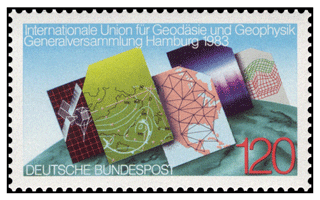
Figure 5Stamp celebrating the XVIII IUGG General Assembly in Hamburg in 1983 (photo: https://commons.wikimedia.org/wiki/File:DBP_1983_1187_GeodC3A4sie_und_Geophysik.jpg, last access: 30 January 2019).
Twenty-one inter-disciplinary symposia were organized, including one on the ocean and CO2 climate response. For the first time, the number of participants adhering to each Association was recorded. Each Association had convened their own scientific assembly between Union Assemblies and it was agreed that the Associations could arrange their own programs within a GA. The Union Committee on Geochemistry was disbanded and the Committee for Advice to Developing Countries was restructured. IUGG named a liaison to the International Hydrographic Organization.
Union resolutions (IUGG Archives, 1983) supported Project MERIT (Measurements of Earth's Rotation and Inter comparison Techniques) and requested WMO support to collect global wind and pressure data; the WCRP's request for meteorological and oceanic data in the North Pacific (i.e., ships-of-opportunity); an ICSU resolution requesting an assessment of the biological and physical effects of the use of nuclear weapons; the need for transportable apparatus for highly accurate absolute gravity measurements; and invited participation in the IUGS/IASPEI Commission on the Geological Map of the World and in the IUGG/IUGS Inter-Union Commission on the Lithosphere. IUGG recommended satellite observations of the middle atmosphere to reliably predict the effects of human activities; MST/ST radars and lidars near equatorial latitudes to study the equatorial middle atmosphere; and links between international aviation organizations and IAVCEI with regard to aircraft and volcanic ash plumes. IUGG urged national support for training seminars for the African Doppler Survey; information necessary to obtain navigational positions from the new USA and USSR satellite systems; high-latitude orbiting satellites to record surface elevations of the Antarctic and Greenland ice sheets; support for UNESCO's Regional Office for Science and Technology for Southeast Asia (ROSTSEA) to establish a center for volcanological studies; participation in several ICSU programs on solar–terrestrial interactions; calibrated radiation energy exchange observations in data-poor regions for studies of climate systems; and that compilations of climate data be made available in convenient format at concessional rates especially to scientists in developing countries.
4.8 XIX General Assembly (9–22 August 1987, Vancouver, Canada)
IUGG President Devendra Lal (India) presided. Other members of the Bureau were Vice President Carl Kisslinger (USA), Secretary General Paul Melchior (Belgium), Treasurer Ole Bedsted Andersen (Denmark), and members James Dooge (Ireland), Vladimir Keilis-Borok (USSR), and Helmut Moritz (Austria). The Canadian National Research Council (Larkin Kerwin, President) and the University of British Colombia (David W. Strangway, President) were the primary co-hosts for the Assembly. The Chair of the Canadian National Committee for Geodesy and Geophysics was Gordon A. McBean. The Assembly took place on the campus of the University of British Columbia. AGU agreed to publish 10 IUGG volumes in its Geophysical Monograph series based on the presentations by Union Lecturers and selected talks at 20 inter-Association symposia (see Appendix B). Poster sessions were encouraged at the Assembly. In his opening address, President Lal referenced the observed depletion of ozone in the Antarctic and dramatic changes in atmospheric CO2 and temperature.
The Union Committee on the Study of the Earth's Deep Interior (SEDI) was established in 1987 to cut across the traditional discipline-oriented bounds of the Associations (especially IAG, IAGA, IASPEI, and IAVCEI) to develop a coherent and consistent picture of the workings of the Earth's interior. The only other two Union Committees reporting were the CMG and the Committee for Advice to Developing Countries. In cooperation with the IAU, IUGG established in 1988 the International Earth Rotation Service (IERS). Numerous inter-Union relationships continued and there was a plea to extend the termination date of the International Program on the Lithosphere. A workshop was proposed to consider the possible contributions of IUGG to the International Geosphere-Biosphere Programme (IGBP), a new ICSU interdisciplinary program. The generous support of UNESCO to the Associations was acknowledged. SCOPE published a seminal report, “The greenhouse effect, climatic change and ecosystems”, which summarized the scientific findings of a 1985 conference on the “Assessment of the Role of Carbon Dioxide and of Other Greenhouse Gases in Climate Variations and Associated Impacts” co-sponsored by ICSU, WMO, and the United Nations Environmental Program (UNEP). This was the first comprehensive international assessment of the environmental impact of atmospheric greenhouse gases.
Nine resolutions were passed (IUGG Archives, 1987). They supported decisions by URSI and IAU to approve the Bureau International des Poids et Mesures (BIPM) as the authority for International Atomic Time; the establishment of the International Decade for Natural Hazard Reduction for the period 1990 to 2000; and IGBP activities. IUGG recommended installation of new and recalibrated tide gauges to include telemetered measurements of atmospheric pressure and geodetic position; and the launch of a dedicated satellite gravity mission by the mid-1990s. IUGG urged modernization of ICSU data management systems; and reconsideration by countries planning to close down long-standing geophysical observatories and stations.
4.9 XX General Assembly (11–24 August 1991, Vienna, Austria)
IUGG President Vladimir I. Keilis-Borok (USSR) presided. Other members of the Bureau were Vice President Carl Kisslinger (USA), Secretary General Paul Melchior (Belgium), Treasurer Soren Gregersen (Denmark), and members Gordon McBean (Canada), Helmut Moritz (Austria), and Ye Duzheng (China). This was Paul Melchior's last General Assembly; he had served as IUGG Secretary General and Adjoint Secretary General for 20 years. The Austrian National Committee of Geodesy and Geophysics hosted the Assembly at the Technical University of Vienna. Hans Sünkel was the Chair of the local organizing committee. Maria Fekter, Secretary of State and Minister of Economic Affairs addressed the Opening Ceremony. AGU continued to publish the Union Lectures and Symposia as IUGG volumes in its Geophysical Monograph series, and eight volumes were published during 1992–1994 (see Appendix B).
During this GA, a political upheaval occurred in the USSR that was of great concern to the delegates at the Assembly from that country, some of whom feared they could not go home. It would be remiss not to include this memory of the General Assembly and the personal impact it had on all of the delegates. While the worst outcome did not happen then, ultimately, the ramifications of this event changed the very structure of IUGG. The USSR delegates left their country for Vienna to attend the IUGG General Assembly, and returned to their country in political chaos, which would disintegrate in a few months into 15 independent states. In 1992, Russia replaced the USSR as a member of IUGG, and four other countries of the former Soviet Union joined the Union later: Armenia, Azerbaijan, Estonia, and Georgia.
Another geopolitical situation influenced this quadrennium. IUGG adherence to ICSU resolution on the Free Circulation of Scientists caused the joint scientific assemblies of IAGA and IASPEI in 1989, originally planned in Oslo, Norway, to be relocated because the Government of Norway, in protest to the conditions of apartheid then present in South Africa, decided in 1987 not to issue visas to South African applicants. Neither could the University of Oslo permit entrance into University facilities, including meeting rooms, of South African nationals. As a result, the joint IAGA/IASPEI assembly in Oslo was cancelled. In 1989, IAGA met in Exeter, UK, and IASPEI met in Istanbul, Turkey.
Besides the usual Union symposia and Association scientific talks and poster sessions, there was continued general discussion of how to improve the capacity for science in developing countries. It was decided that the Associations could best provide support, and the IUGG Committee on Advice to Developing Countries was discontinued (however, it was reinstated at the 1995 GA). The ILP continued as an inter-Union (IUGG/IUGS) body. Under the leadership of IAG, the first International Terrestrial Reference Frame (ITRF) was released in 1988.
Union resolutions (IUGG Archives, 1991) supported an IAU resolution defining the Conventional Terrestrial Reference System and further specified system requirements; and the installation and operation of ocean-bottom observing systems that use submarine cables abandoned by telephone companies. IUGG recommended a major campaign for high time resolution measurement of Earth rotation by space techniques to be coordinated with the International Earth Rotation Service (IERS); implementation of a dedicated mission (ARISTOTELES) for the improved determination of the Earth's gravity and magnetic fields; the concept of an International GPS Geodynamic Service (IGS), and that existing global geodetic systems be used to carry out intensive observing campaigns; development of additional knowledge needed to reduce the disastrous effects of extreme natural events. IUGG urged that organizations, agencies, and Member countries optimize and possibly co-locate the geographical distribution of stations that make continuous Earth and space observations.
4.10 XXI General Assembly (2–14 July 1995, Boulder, Colorado, USA)
IUGG President Helmut Moritz (Austria) presided. Other members of the Bureau were Vice President Peter Wyllie (USA), Secretary General Georges Balmino (France), Treasurer Søren Gregersen (Denmark), and members Gordon McBean (Canada), Ye Duzheng (China), and Andrei Monin (Russa). The theme of the General Assembly was “Geophysics and the Environment”, and IUGG celebrated its 75th anniversary looking forward to the challenges for the next 25 years. The US National Committee for Geodesy and Geophysics, under the National Academy of Sciences, was the host, and AGU served as the local organizing committee. Chris Harrison was the Chair of the US National Committee, and David S. Chapman acted as Chair of the Local Organizing Committee. Carl Kisslinger led the Colorado Host Committee. The International Association for the Physical Sciences of the Oceans did not attend this Assembly. However, Chris Mooers organized several inter-disciplinary symposia that offered an oceans sciences component to the program.
At this GA, IAMAP was renamed IAMAS (“Sciences” instead of “Physics”). IUGG discontinued a formal link with the Pacific Science Association and reinstated the Committee for Developing Countries. IUGG formed the Committee for the Problems of the International Decade for National Disaster Reduction (IDNDR) as a Union response to IDNDR, established by the decision of the UN General Assembly in 1991; this Commission evolved into the Commission on Geophysical Risk and Sustainability in 2000. IAG established the International Service for Geodynamics (IGS) in 1994 after a successful pilot program of more than a year. IGS provides the status (including orbits) for all GPS satellites as well as other positioning data and products.
Union resolutions (IUGG Archives, 1995) recommended that national agencies and institutions contribute to the operation of the International Earth Rotation Service; the implementation of a dedicated satellite gravity mission; and that IAU work with IUGG to define of a timescale including a convention for the continuous counting of days adapted to the archival and exchange of time-dependent data used in analysis of astronomical as well as geodetic and geophysical phenomena. IUGG urged support of research programs aimed at the design, deployment, and operation of ocean-bottom magnetic observatories.
4.11 XXII General Assembly (19–30 July 1999, Birmingham, UK)
President Peter J. Wyllie (USA) presided. Other members of the Bureau were Vice President Uri Shamir (Israel), Secretary General Georges Balmino (France), Treasurer Søren Gregersen (Denmark), and members Jianyun Chen (China), Andrei S. Monin (Russia), and Seiya Uyeda (Japan). Graham Westbrook chaired the Local Organizing Committee, and Kathryn Whaler chaired the Scientific Programme Committee. Held on the campus of the University of Birmingham, the informal theme was “Geoscience in the Service of Society.” Seven Union Symposia, 48 Joint Symposia, and four Union Lectures were presented. The topic of climate change was discussed widely.
The Union Megacities Task Force, and the Alliance for Capacity Transfer were initiated. The Committee for Developing Countries, reinstated in 1995, was again disbanded and funds were allocated for inter-Association initiative grants to benefit developing countries. Reports were received from the ILP, CMG, SEDI, and the Inter-Association Tsunami Committee; all had held successful meetings. Uri Shamir attended as the IUGG representative to the UNESCO/ICSU World Conference on Science in Budapest in June 1999. IAPSO further modified their name by adding an “s” to Ocean to become the “International Association for the Physical Sciences of the Oceans.”
Union resolutions (IUGG Archives, 1999) supported the Integrated Global Earth Monitoring Systems (IGEMS) and the free and unrestricted transfer of data; studies of the prevention and mitigation of natural disasters in continuation of the IDNDR program beyond the decade including the problems of megacities; the International Human Dimensions Program (IHDP), WCRP, and IGBP. The Union recommended that ITU should not make changes to the existing allocations of the radio frequencies for Global Navigation Satellite Systems; and that open, free, and un-delayed access to all raw and processed waveform data be made available from the International Monitoring System (IMS) for the Comprehensive Test Ban Treaty (CTBT) to seismological data centers.
This section highlights those extraordinary scientists and science administrators who led the Union and significantly contributed to IUGG development after WWII until the end of the 20th century.
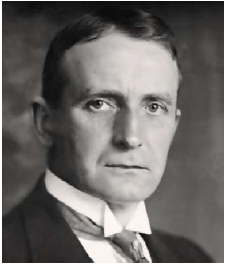
Bjørn Helland-Hansen, President (1946–1948): Bjørn Helland-Hansen (Norway, 1877–1957) was an oceanographer. He studied the variation patterns of the weather in the northern Atlantic Ocean and of the atmosphere. He graduated from the University of Christiania (now University of Oslo). He became Professor of Oceanography at the Bergen Museum in 1915, and Director of the Geophysical Institute, University of Bergen in 1917. Helland-Hansen was President of IAPSO from 1936 to 1946 before he was elected IUGG President. He was a member of the Prussian Academy of Sciences and a member of the Member of the Academy of Sciences of the German Democratic Republic. An island in the Russian Arctic, east of the Geiberg Islands, was named “Gellanda-Gansena” after Helland-Hansen. (Courtesy of Ukjent/NTB).

James Martin Stagg, Secretary General (1946–1951): James M. Stagg (UK, 1900–1975) was active in IATME, the predecessor to IAGA. He was leader of the British Polar Year Expedition to Arctic Canada, 1932–1933, and received his PhD from Edinburgh University in 1936. He was Superintendent of the Kew Observatory in 1939. He was Chief Meteorological Officer for the Supreme Command, Allied Forces, Europe 1943–1945, and was Director of Services for the Meteorological Office in 1944–1946. As IUGG Secretary General, he was instrumental in the post-war reconstruction leading to the Eighth General Assembly in Oslo in 1948, ensuring the continuation of IUGG and restarting its development. He was elected as president of the Royal Meteorological Society in 1959. At the time of his death he was President of the IUGG Finance Committee, having served on the Committee since 1967. (Source: IUGG archives)
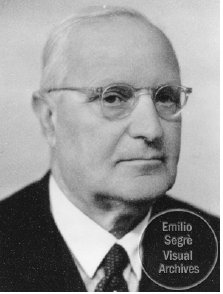
Felix A. Vening-Meinesz, President (1948–1951): Felix Andries Vening-Meinesz (the Netherlands, 1887–1966) was a geodesist and geophysicist. One of the leading geoscientists of the first half of the 20th century, he began his career making gravity measurements at sea in order to determine the shape of the geoid. Discoveries of anomalies in the gravity field led him to develop new theories about the mechanics of the Earth's crust and mantle and continental drift. He was a professor of geophysics and geodesy at the universities of Utrecht and Delft, and was the Director of the Royal Dutch Meteorological Institute (KNMI). He served as IAG President from 1933 to 1945. He was a Member of the Royal Netherlands Academy of Arts and Sciences, and Fellow of the Royal Society. A gravimeter and a mathematical function used in geodesy, and a crater on the Moon, are named after Vening-Meinesz. The European Geoscience Union's Geodesy Division established the Medal in recognition of the scientific achievements of Vening-Meinesz. (Courtesy of AIP Emilio Segrè Visual Archives)

Sydney Chapman, President (1951–1954): Sydney Chapman (UK, 1888–1970) was a geophysicist and mathematician, and graduated from the University of Manchester and Trinity College Cambridge. Chapman is recognized as one of the pioneers of solar–terrestrial physics. In 1946, Chapman coined the term “aeronomy”, which is used today to describe the scientific field of high-altitude research into atmosphere–space interaction. During his distinguished career he was affiliated with the universities of Cambridge, Manchester, London, Oxford, Alaska, and Colorado. Chapman was also IAMAS President (1936–1948) and IAGA President (1948–1951). He served as Chair of the Special Committee for the IGY (1953–1958). He was elected fellow of several national academies, including the Royal Society and US National Academy of Sciences. Lunar crater Chapman is named in his honor. AGU organizes “Chapman Conferences”, and the Royal Astronomical Society established the Chapman Medal in his memory. (Source: IUGG archives)

Georges R. Laclavère, Secretary General (1951–1963): Colonel Georges R. Laclavère (France, 1906–1994) was Chief Editor of the IUGG Chronicle from 1957 to 1990. He also served for many years as the FAGS Secretary. His early career was in surveying and geodetic work in France and Morocco, becoming Ingenieur Géographique for the Institut Géographique National (IGN) in Paris, France, in 1940. He became Director General of the IGN in 1963 and was instrumental in bringing IGN into the space age. He was a member of the Special Committee for the IGY (1956–1957), the first elected President of the ICSU Scientific Committee on Antarctic Research (1958–1963), and was a Bureau member and Treasurer of ICSU (1959–1965). (Courtesy of AIP Emilio Segrè Visual Archives)
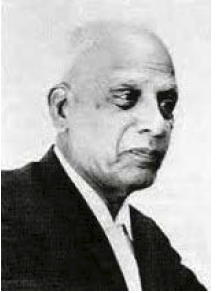
Kalpathi R. Ramanathan, President (1954–1957): Kalpathi Ramakrishna Ramanathan (India, 1893–1984) was a physicist and meteorologist. He started his research career with Nobel Laureate Chandrasekhara V. Raman with their pioneering paper on the X-ray diffraction of liquids (1923). He was known for his discovery work on ozone and airglow, and contributed actively in the areas of ionospheric physics, space physics, geomagnetism and radio astronomy. He became the Founder-Director of the Physical Research Laboratory at Ahmedabad in 1947, after his retirement from the India Meteorological Department. He served as IAMAS President from 1951 to 1954. He was a Fellow of the Indian Academy of Sciences and an Honorary Fellow of the Royal Meteorological Society of London. The Indian National Science Academy established the Kalpathi Ramakrishna Ramanathan Medal in 1987 in honor of him. (Courtesy of Creative Commons BY-SA 4.0)
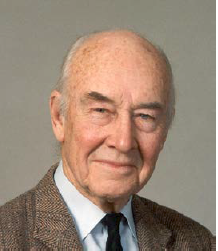
John Tuzo Wilson, President (1957–1960): John Tuzo Wilson (Canada, 1908–1993) was a geophysicist and geologist who achieved worldwide acclaim for his contributions to the theory of plate tectonics. He graduated from Trinity College at the University of Toronto in 1930, and obtained his PhD in geology in 1936 from Princeton University. After completing his studies, Wilson enlisted in the Canadian Army and served in World War II; he retired from the army with the rank of Colonel. He was the Principal of Erindale College at the University of Toronto, and the Director General of the Ontario Science Centre. J. Tuzo Wilson served IUGG as Chair of Finance Committee (1948–1954) and Vice President (1954–1957). He was a Fellow of the Royal Society of Canada, of the Royal Society of London and of the Royal Society of Edinburgh. He was AGU President. The John Tuzo Wilson Medal of the Canadian Geophysical Union recognizes achievements in geophysics. His name was given to two young Canadian submarine volcanoes called the Tuzo Wilson Seamounts. The Wilson cycle of seabed expansion and contraction bears his name. (Courtesy of Creative Commons BY-SA 3.0)

Vladimir V. Beloussov, President (1960–1963): Vladimir Vladimirovich Beloussov (USSR, 1907–1990) was a geoscientist, and a prominent advocate of alternatives to the theories of plate tectonics and seafloor spreading during the period of the 20th century in which debate on these subjects was most intense. Beloussov graduated from the Lomonosov Moscow State University and Leningrad State University, and received his PhD in 1938 from the USSR Academy of Sciences. He was head of the Geodynamics Department of the Smidt Institute of the Physics of the Earth of the USSR Academy of Sciences in Moscow. and Professor at the Moscow Geological Surveyance Institute (1943–1949) and the Lomonosov Moscow State University (1953–1990). During the 1960s he led three expeditions to the East African Rift to study continental structure and the Earth's mantle. Beloussov served as Member of the Special Committee for the IGY from 1954 to 1958 and was IUGG Vice President (1957–1960). He was an initiator and Chair of the IUGG Upper Mantle Project (1964–1970). He was elected to the USSR Academy of Sciences and several national academies. (Courtesy of the Russian Academy of Sciences)
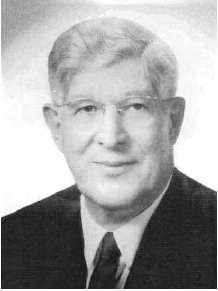
Joseph Kaplan, President (1963–1967): Joseph Kaplan (USA, 1902–1991) was a chemist and atmospheric scientist. He graduated from the Baltimore Polytechnic Institute (1921), earned a bachelor's degree in chemistry (1924), and a doctorate in physics (1927) from Johns Hopkins University. His research, largely concerned with the spectra of diatomic molecules and, more specifically, in afterglows of nitrogen and oxygen and their mixtures, began at Princeton University. In 1928, he accepted an assistant professorship at the University of California at Los Angeles (UCLA), becoming an associate professor in 1935 and a full professor in 1940. He was appointed chairman of the Department of Physics (1939–1944) and director of the Institute of Geophysics (1946–1947). Kaplan became chairman of the U.S. National Committee for the IGY (1953–1963). He served IUGG as Vice President (1960–1963), and was an Ordinary Member of the ICSU Executive Board (1962–1967). He was elected to membership in the US National Academy of Sciences (1957) as well as numerous other scientific societies. (Courtesy of the National Academies Press)
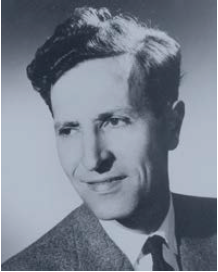
Jean Coulomb, President (1967–1971): Jean Coulomb (France, 1904–1999) was a geophysicist and mathematician, and his work was in the fields of seismology (theory of surface waves), geomagnetism, and meteorology (atmospheric electricity and the physics of clouds). He was a professor in the Faculty of Sciences of the University of Paris (1941–1972) and Director of the Institut de Physique du Globe de Paris (1941–1959). He was Director-General of the French National Centre for Scientific Research (CNRS, 1957–1962), President of the French National Centre for Space Studies (CNES, 1962–1967), President of the Bureau des Longitudes (1967–1969), and ICSU President (1972–1974). In 1960, he was elected to the French Academy of Sciences, and served as its President (1976–1977). (Courtesy of Creative Commons BY-SA 4.0)
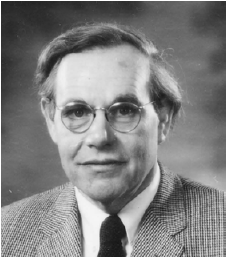
Henry Charnock, President (1971–1975): Henry Charnock (UK, 1920–1997) was a marine meteorologist. He earned his MSc and PhD in meteorology at Imperial College of London. He started his career in the UK National Institute of Oceanography (NIO), accepted a Chair in Physical Oceanography at the University of Southampton in 1966, but returned to the NIO in 1971 as Director. Shortly thereafter, several small laboratories were combined to form the Institute of Oceanographic Sciences with Charnock as Director. He took on the presidency of IUGG to replace the Australian meteorologist Charles H. B. Priestley, who had been formally elected as president but had declined at short notice. He returned to Southampton in 1978 and became Head of the Department in 1979, later Deputy Vice Chancellor of the University (1982–1984). He was SCOR Vice President (1980–1982) and President of the Royal Meteorological Society (1982–1984). He was Fellow of the Royal Society. (Courtesy of the Royal Society)
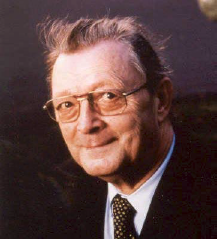
Baron Paul Melchior, Secretary General (1973–1991): Baron Paul Melchior (Belgium, 1926–2004) graduated from the Free University of Brussels. From 1949 he worked at the Royal Observatory of Belgium in Uccle. His major contributions were in the field of geodynamics, studies of the Earth's rotation and tidal deformations. Among his many duties, he was Director of the Royal Observatory of Belgium from 1981 till 1990, Director of the International Center of Earth Tides from 1958 till 1995 and Professor at the Université Catholique de Louvain from 1972 till 1990. Melchior was elected AGU Fellow, Honorary Fellow of the Royal Astronomical Society, and foreign Member of the Finnish, Spanish, The Netherlands, and Romanian academies of sciences. The IUGG Bureau bestowed a title of Honorary Secretary General to Baron Paul Melchior for his outstanding service to IUGG. (Courtesy of the Royal Observatory of Belgium)

Attia Ashour, President (1975–1979): Attia Abdel Salam Ashour (Egypt, 1924–2017) was a physicist and mathematician. His work was in the field of theoretical geomagnetism and other physical and mathematical fields. He obtained his BSc in Mathematics (1944), PhD (1948), and DSc (1967). He started his teaching career in the Mathematics Department, University of Cairo (UoC), Egypt, and became professor of UoC in 1948, Head of the Mathematics Department for about 15 years before his retirement in 1984. Ashour was visiting professor in France, Germany, Italy, Nigeria, and UK. He served IUGG as Vice President (1975–1979), and Member (1983–1995) and Chair (1995–1999) of Finance Committee. He was fellow and Vice President of the African Academy of Sciences, and President of the International Centre of Pure and Applied Mathematics in Nice, France (1992–1996). He was a Member of the Advisory Board to the Director General of UNESCO on “Science and the 21st Century”. Ashour was an IUGG Fellow and elected fellow of several national societies and academies. (Source: IUGG archives)
George Garland, President (1979–1983) and Secretary General (1963–1973): George D. Garland (Canada, 1926–2008) was professor of the Department of Physics, University of Toronto, Toronto, Canada. Garland obtained his B.A. in 1947 from the University of Toronto and PhD in 1951 from St. Louis University (USA). Garland became a lecturer at the University of Toronto in 1951 and moved to Ottawa in 1952 to work at the Dominion Observatory. He got a professorship at the University of Alberta in 1954 and worked there until 1963, when J. Tuzo Wilson invited him to join the faculty of the University of Toronto. In 1959 Garland was elected Fellow of the Royal Society of Canada and served for the Society as its Foreign Secretary (1984–1986). Garland was IUGG Secretary General (1963–1973). (No image available)
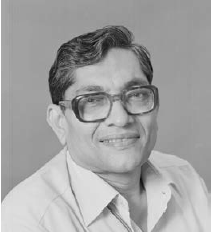
Devendra Lal, IUGG President (1983–1987): Devendra Lal (India, 1929–2012) was a geophysicist. His works was in the field of cosmic radiation, physical and chemical processes on Earth and in the solar system, nuclear tracks and radioactivity in lunar samples and meteorites. He obtained his bachelor (1947) and master degrees (1949) from Banaras Hindu University in Varanasi, India, and PhD degree from the Tata Institute of Fundamental Research in Bombay (Mumbai) and Bombay University in 1960. He was appointed Professor in Nuclear Geophysics in 1967 and was Visiting Professor at Scripps Institution of Oceanography, University of California at San Diego, USA, divided his time between Scripps and appointments in India, first as a professor at the Tata Institute and then as professor and director of the Physical Research Laboratory in Ahmedabad (1972–1983), before making Scripps his full-time academic home (1989–2012). He was elected fellow of several national academies, including the Royal Society and US National Academy of Sciences. (Source: IUGG archives)
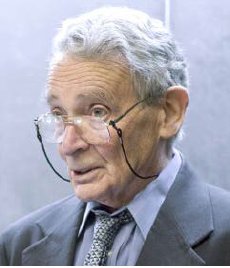
Vladimir I. Keilis-Borok, President (1987–1991): Vladimir Isaakovich Keilis-Borok (USSR, 1921–2013) was one of the most influential mathematical geophysicists of the last century. He graduated from the Moscow State Geological Prospecting University in 1943 and received his PhD (1948) and DSc (Habilitation, 1953) in mathematics and geophysics from the USSR Academy of Sciences in Moscow. He worked at the Academy's Institute of Physics of the Earth (1948–1989), and chaired its Department of Computational Seismology. In 1989, he founded the Institute of Earthquake Prediction Theory and Mathematical Geophysics at the Academy and was its first Director. In 1999, he moved to the USA to take a position of distinguished professor of UCLA. He was the founder of the IUGG International Committee for Geophysical Theory and Computers (1964–1979, now CMG), and served IUGG as a Bureau Member (1983–1987) and IASPEI Vice President (1983–1987). He was elected Ordinary Member of the ICSU Executive Board (1988–1991). Keilis-Borok was elected fellow of many national academies incl. the US National Academy of Sciences, Russian Academy of Sciences, Pontific Academy of Sciences, and Academia Europaea. (Courtesy of Alik Ismail-Zadeh)
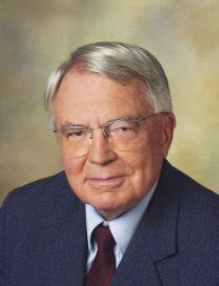
Helmut Moritz, President (1991–1995): Helmut Moritz (Austria, born in 1933) is a physical geodesist. His work is in the fields of general geophysics, geodynamics, gravimetry, theoretical mechanics, and the theory of relativity. He graduated from the Graz University of Technology (TUG) in 1956 and obtained his doctoral degree in 1959 (TUG). Since 1955 he has held various positions at TUG, Geodetic Service of Austria, Ohio State University, Technical University Hannover, and Wuhan University. He was Professor of Physical Geodesy at the Technical University Berlin (1964–1971), and then Professor of Geodesy at the TUG Institute of Navigation (1971–2002), becoming Professor Emeritus at TUG. He was IAG President (1979–1983) and IUGG Bureau Member (1983–1991), and is an IUGG Fellow (2015). He was elected to the Austrian Academy of Sciences and several national academies. (Source: IUGG archives)
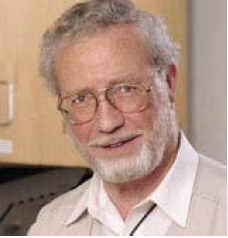
Peter J. Wyllie, President (1995–1999): Peter John Wyllie (USA, born in 1930, England) is a geophysicist and petrologist. He graduated from the University of St. Andrews (Scotland) in geology and physics, spending 1952–1954 as geologist with the British North Greenland Expedition. He has worked at St. Andrews, Pennsylvania State University, Leeds University, Penn State, the University of Chicago, and the California Institute of Technology (1983–1999), with terms as Department Chairman in Chicago (1979–1982) and Caltech (1983–1987), and Academic Officer at Caltech (1994–1999) until retirement. Wyllie has worked with many national and international committees and societies, culminating with 12 years on the IUGG Executive Committee (Vice President 1991–1995, President 1995–1999, Past-President 1999–2003; IUGG Fellow, 2015). Wyllie is a fellow or foreign member of several national academies, including the US National Academy of Sciences, Royal Society, Russian Academy of Sciences, Chinese Academy of Sciences, and Academia Europaea, and is an honorary fellow of several professional societies. (Source: IUGG archives)

Georges G. Balmino, Secretary General (1991–1999): Georges Balmino (France, born 1945 in Germany) is Emeritus Scientist at CNES and OMP (Observatory Midi-Pyrenees), Toulouse, France. He received a PhD in mathematics (1969) and a Habilitation degree in physics and astronomy (1973). He worked as a scientist at Meudon Observatory (1968–1972) and engineer then scientist at CNES and OMP (1973–2006): Head of Department of Terrestrial and Planetary Geodesy, head of the Space Geodesy group. Co-founder of the GOCE gravity consortium (European Space Agency). Director of Bureau Gravimetrique International (1979–1999); Executive Director, Groupe de Recherche de Geodesie Spatiale (1997–2004); Adjoint Professor, then Professor at Toulouse University (1974–1985). He is a member of Academia Europaea, Air & Space Academy, and Bureau des Longitudes, and fellow of AGU, IAG, and IUGG. (Source: IUGG archives)
IUGG of 1999 was remarkably different than IUGG of 1940 – a finding that applies generally to much of the geopolitical landscape. The seven International Associations remained intact (although several changed their names), but the scope of their scientific studies and their methodologies changed dramatically, especially with the advent of artificial satellites orbiting the Earth and extending into interplanetary space. International cooperation became commonplace after the success of the International Geophysical Year (1957–1958). The evidence for and discussion of global climate change began to permeate the General Assemblies. It was an exciting time for geodesy and geophysics.
The paper is based on (i) published documents (see a list of references) as well as (ii) IUGG Archive documents. The original hard-copy documents of IUGG are deposited in the Niels Bohr Library and Archives of the American Institute of Physics (AIP, 2019). The documents are accessible only in the library with the permission of the IUGG Secretary General.
JAJ and AIZ contributed equally to the analysis and writing the paper; JAJ visited the AIP Niels Bohr Library and Archives to work with IUGG Archive documents; and AIZ prepared the manuscript for publication.
The authors declare that they have no conflict of interest.
This article is part of the special issue “The International Union of Geodesy and Geophysics: from different spheres to a common globe” (https://www.hist-geo-space-sci.net/special_issue996.html). It is not associated with a conference.
The authors are grateful to Tom Beer, Ron Doel, Harsh Gupta, Masaru Kono, and
Uri Shamir for useful discussion, review, and comments on the initial
manuscript, and thank Hans Volkert for providing references to some
publications on IUGG history. The authors are grateful to Gregory A. Good,
Georges Balmino, and Kristian Schlegel for their review of the manuscript and
comments.
Edited by: Kristian Schlegel
Reviewed by: Gregory A. Good and Georges Balmino
AIP: Records of the International Union of Geodesy and Geophysics, 1922–2000 (bulk 1955–1998), Description of collection, American Institute of Physics, Center for History of Physics, available at: https://history.aip.org/ead/20010000.html, last access: 30 January 2019.
Aronova, E., Baker, K., and Oreskes, N.: Big science and big data in biology: From the International Geophysical Year through the International Biological Program to the Long Term Ecological Research (LTER) Network, 1957-present, Hist. Stud. Nat. Sci., 40, 183–224, 2010.
Bedritskii, A. I., Borisenkov, Y. P., Korovchenko, A. S., and Pasetsky, B. M.: Essays on History of the Russian Hydrometeorological Service, volume 1, Gidromet, St. Petersburg, 341 pp., 1997 (in Russian).
Bulkeley, R.: Aspects of the Soviet IGY, Russ. J. Earth. Sci., 10, ES1003, https://doi.org/10.2205/2007ES000249, 2008.
Collis, C. and Dodds, K.: Assault on the unknown: the historical and political geographies of the International Geophysical Year (1957–8), J. Hist. Geogr., 34, 555–573, 2008.
Cox, J. F.: Report of the Chair of the Local Organizing Committee for the IXth General Assembly of the IUGG, Belgian National Committee for Geodesy and Geophysics, Brussels, 28 pp., 1951.
CSAGI: The Second Meeting of the CSAGI: General Report, Annals of the IGY, 2A, 77 pp., 1958.
Harrison, J. M.: The roots of IUGS, Episodes, 1, 20–23, 1978.
Ismail-Zadeh, A.: Geoscience international: the role of scientific unions, Hist. Geo Space Sci., 7, 103–123, https://doi.org/10.5194/hgss-7-103-2016, 2016.
IUGG Archives: Resolutions adopted by the XIth General Assembly, Toronto, available at: http://www.iugg.org/resolutions/IUGG_Resolutions_1957.pdf (last access: 16 January 2019), Canada, 1957.
IUGG Archives: Resolutions adopted by the XIIth General Assembly, Helsinki, Finland, available at: http://www.iugg.org/resolutions/IUGG_Resolutions_1960.pdf (last access: 16 January 2019), 1960.
IUGG Archives: Resolutions adopted by the XIIIth General Assembly, Berkeley, USA, available at: http://www.iugg.org/resolutions/IUGG_Resolutions_1963.pdf (last access: 16 January 2019), 1963.
IUGG Archives: Resolutions of the Union adopted by the 14th General Assembly, Zurich, Switzerland, available at: http://www.iugg.org/resolutions/zurich.pdf (last access: 16 January 2019), 1967.
IUGG Archives: Resolutions of the Union adopted by the 15th General Assembly, Moscow, USSR, available at: http://www.iugg.org/resolutions/moscow.pdf (last access: 16 January 2019), 1971.
IUGG Archives: Resolutions of the Union adopted by the 16th General Assembly, Grenoble, France, available at: http://www.iugg.org/resolutions/grenoble.pdf (last access: 16 January 2019), 1975.
IUGG Archives: Resolutions of the Union adopted by the 18th General Assembly, Hamburg, Germany, available at: http://www.iugg.org/resolutions/hamburg.pdf (last access: 16 January 2019, 1983.
IUGG Archives: Resolutions of the Union adopted by the 19th General Assembly, Vancouver, Canada, available at: http://www.iugg.org/resolutions/vancouver.pdf (last access: 16 January 2019), 1987.
IUGG Archives: Resolutions of the Union adopted by the 20th General Assembly, Vienna, Austria, available at: http://www.iugg.org/resolutions/vienna.pdf (last access: 16 January 2019), 1991.
IUGG Archives: Resolutions of the Union adopted by the 21th General Assembly, Boulder, USA, available at: http://www.iugg.org/resolutions/boulder95.pdf (last access: 16 January 2019), 1995.
IUGG Archives: Resolutions of the Union adopted by the 22th General Assembly, Birmingham, UK, available at: http://www.iugg.org/resolutions/birmingham99.pdf (last access: 16 January 2019), 1999.
IUGG Chronicles: Resolutions of the Union, in: Comptes Rendus of the 17th General Assembly, Canberra, Australia, 1979, edited by: Melchior, P., available at: http://www.iugg.org/resolutions/1979_IUGG_GA_Resolutions.pdf (last access: 16 January 2019), I.U.G.G. Chronicle, 146, 618–627, 1980.
Korsmo, F.: The genesis of the International Geophysical Year, Phys. Today, 60, 38–43, 2007.
Launius, R. D., Fleming, J. R., and DeVorkin, D. H. (Eds.): Globalizing polar science: reconsidering the International Polar and Geophysical Years, Plagrave Macmillan, New York, 2010.
Needell, A. A.: Science, Cold War, and the American State: Lloyd Berkner and the Balance of Professional Ideals, Harwood Academic Publishers, London, 2000.
Proudman, J.: International Union of Geodesy and Geophysics, Nature, 162, 744–745, 1948.
Stagg, J. M.: The International Union of Geodesy and Geophysics, Nature, 160, 558–559, 1947.
Stagg, J. M. (Ed.): Eight General Assembly of IUGG, Oslo, 19–28 August 1948, IUGG Publication No. 11, 1948.
Sullivan, W.: Assault on the Unknown: The International Geophysical Year, McGraw-Hill, New York, 1961.
WMO: Working Arrangements with the International Union of Geodesy and Geophysics, in: The World Meteorological Organization Basic Documents No. 3. Agreements and Working Arrangements with other international organizations, 2002 edn. (WMO-No. 60), available at: http://library.wmo.int/pmb_ged/wmo_60_en-2002.pdf (p. 129–130; last access: 13 August 2017), WMO, Geneva, 2002.






